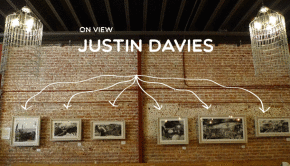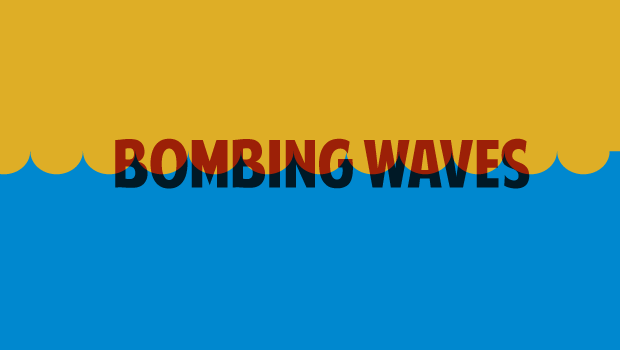Q&A: These Puns Are Art, Okay
E. B. White used to say that analyzing humor is like dissecting a frog. “Few people are interested and the frog dies of it.” But what about when art is the joke, or when humor is a work of art? This year marks the first (and maybe only) semester where University of Hawaii students can take a class, Art 400: Humor in Art: Mixed Media Sculpture, that dissects these questions.
Right now, on view in the Art Department Art Gallery through February 21, students of the class are featured in a brief show titled, Crime & Punishment (emphasis on the pun), where each of the students are asked to illustrate a pun. Laura Konecne’s die-cast fish sit in a circle of classroom chairs for her school of fish, and our own “Sad Ricky” Eric Peters put a rock in the corner of the room for his piece, titled “Cornerstone”.
We talked with Lauren Jo, Art 400’s lecturer, about why she created this class and how humor fits into art. The conversation below is edited from an interview.
How did Art 400 come to be?
When Fred Roster [chair of the sculpture program at the University of Hawaii] and I were coming up with the curriculum for this class, we wanted to do something that was based in materials exploration, and I guess [Art Department Chair] Gaye Chan thought it would be interesting to do something that was theme-based, rather than process-driven like most of the other sculpture courses. Humor in art was something that we just automatically agreed would be interesting to try to teach, and in trying to come up with the curriculum, it was actually really difficult to pin down any of the definitions, because, like art, humor is a very broad and nebulous term that encompasses a lot of various things. Trying to figure that out is part of the impetus for this class.
So how do you address that challenge in class?
We’re doing it through class discussions, because there is no set definition. If we can come up in class with parameters of what we agree to be humor and art then we can start exploring those.
We’re still trying to flesh out how to navigate through humor, especially in art. John Baldessari is an example. There’s a whole bunch of artists on our class blog that people have shared. We’re trying to foster discussion on why it’s humorous and what they’re trying to do and how they accomplish it. I guess humor has a bad rap for being pretty flat and one dimensional. It’s an interesting paradox that the art world tends to take itself really seriously and can’t see anything deeper in humorus art, but there are some artist who do it successfully. There’s a twinge of humor to numerous things that Ai Wei Wei does.
Is your class about sculpture, or are you exploring humor in other mediums of art?
It’s interesting, because my background is in sculpture, but in this class there are students who are more well-versed in photography or drawing and painting, so they bring a lot of things to the table. It creates a nicer balance.
Can humor be taught? And if so, are you teaching the creation of the joke, or the ability to look at something and appreciate the joke?
I think there’s a misconception that humor is implicitly funny. There’s a lot of things that can be seen as humorous, but they’re on the darker side. There are things that are more ironic than actually funny. There’s a lot of different aspects to it. I think that it’s a topic that’s broad enough that no matter where you’re coming from you can see some kind of humor in a lot of different things. No matter what your brand of humor is, there’s a way to explore it. It’s not necessarily something that needs to be taught. But something the student needs to commit to investigating, and to ask questions about. The structure of the class is communal learning. We’re investigating these topics together, the materials together. Each student has different strengths.
You write in the syllabus that as you “uncover the social, psychological, and evolutionary implications that humor holds, we see that it infiltrates aspects of daily life in funny and unexpected ways.” What do you mean?
There’s a lot of different aspects to that. In Sigmund Freud’s humor of the subconscious, humor’s kind of a way you can subconsciously relate to things and other people that might be outside of your social group. Like art, humor is something that could possibly bridge gaps between people.
There are a lot of different ways we use humor. People use humor as a defense mechanism. And there’s the idea of the inside joke creating community. There are reasons behind all these different ways that we use humor. I guess, in the every day, there’s a way to apply that to art as well.
So at the Offsetter, we’re exploring the deficit in local criticism. And that exists because maybe people are too afraid to speak publicly about something because it’s a small city. So, especially when we satirize something, we’re trying to look at humor as a sort of back door into criticism. Like, you can make a joke about something and that’s a form of criticism. Do you see humor as a way to introduce someone to criticism?
Humor can definitely be a form of criticism. Like you said, when you make things satirical, it kind of softens the blow. So, utilized in the right way, it could be a very effective way of conveying meaning and messages and I think that people do kind of underestimate the power of humor to relate to people and to say things that are a little more meaningful than just taking them at face value.
The show at the UH Art Department Gallery, Crime and Punishment, feels like you’re defending the pun. Do you stand in defense of the pun?
I do stand in defense of the pun. People are really quick to brush it off as corny or really simple, so they can’t be bothered with it. But as a brainstorming tool it’s an interesting way of forming connections that you wouldn’t normally think of. Very many people utilize that and incorporate that in their work. And other people don’t really see it as a viable way of making meaning or way of making anything, just like a one-liner that you can look at and there’s nothing else to look at. There’s actually a lot of historical context or historical use of punning in social circles. And in a lot of different cultures, it takes different forms. Puns aren’t necessarily funny, but they can definitely be funny. Punning is a form of word play. Like in poetry in ancient Japan, people would write things back and forth and allude to things using puns, playing on words. there’s a lot of this historically, and not all of it is something you would laugh out loud about. Shakespeare incorporates a lot of wordplay in what he wrote. Jonathan Swift—there’s a lot of literary people who utilize wordplay and also stand in defense of puns. Somewhere along the line it diverted from this intellectual practice to the corny one-liner. And so people only see it as that. John Dennis is quoted as saying, “A pun is the lowest form of wit,” and [Henry] Erksine responded with something like, “If pun is the lowest form of wit, it is, therefore, the foundation of all wit.”
I guess Crime and Punishment is to show that puns can be more than just jokes. You can actually create meaning through the different uses of words. And a lot of the puns are funny, because when you look at the statements, there’s a lot more behind it.
You write that this is a class about thinking about thinking. What do you mean?
That’s more of trying to tackle different ways of thinking about things, different ways of brainstorming. By icorporating wordplay and punning into the curriculum, I’m trying to give the students different ways of thinking about things. Trying to do things from a humorous angle, which is a different way of thinking about things, perhaps for some of the students. By incorporating the idea of play in the creative process opens up different avenues in creative problem solving.
Is there anybody in your class without a sense of humor? How do you handle it?
First, I’m still trying to get a handle of everybody’s different brand of humor. It seems like a lot of people are trying way too hard to be punny. Like, Oh hey, I can make this into a joke. It’s a weird evolution of the “why does the chicken cross the road joke”, but I ask, what is it you’re trying to do? At this point in the semester there isn’t anybody in the class that has no sense of humor; they just have a different way of approaching it. As a teacher, it’s figuring out how it works for everyone, trying to develop their own humor’s voice.
It would be really hard to find somebody without any sense of humor, because they probably have one or think that something weird or something else is funny but people don’t see their humor, but I don’t know that you could find anyone with no sense of humor.
Will this class be available next semester?
This one’s an experimental class, so it might be up to Gaye Chan if she wants to let it run again. The other courses are based on traditional practices, and it’s very important to have those skills. The other professors are really good at what they do. She just thought it would be interesting to try something different. I’m not sure if the class is going to run again. It depends on the success of the class.
Do you know any good jokes?
There’s a guy and a duck sitting at a bus stop and the duck turns to him and says, “Social security.” And the guy says, “I don’t get it.” And the duck says, “Yeah, you won’t until you’re 65.”
I have others! What sits at the bottom of the ocean and shakes? A nervous wreck. I got a lot of my jokes from popsicle sticks.







